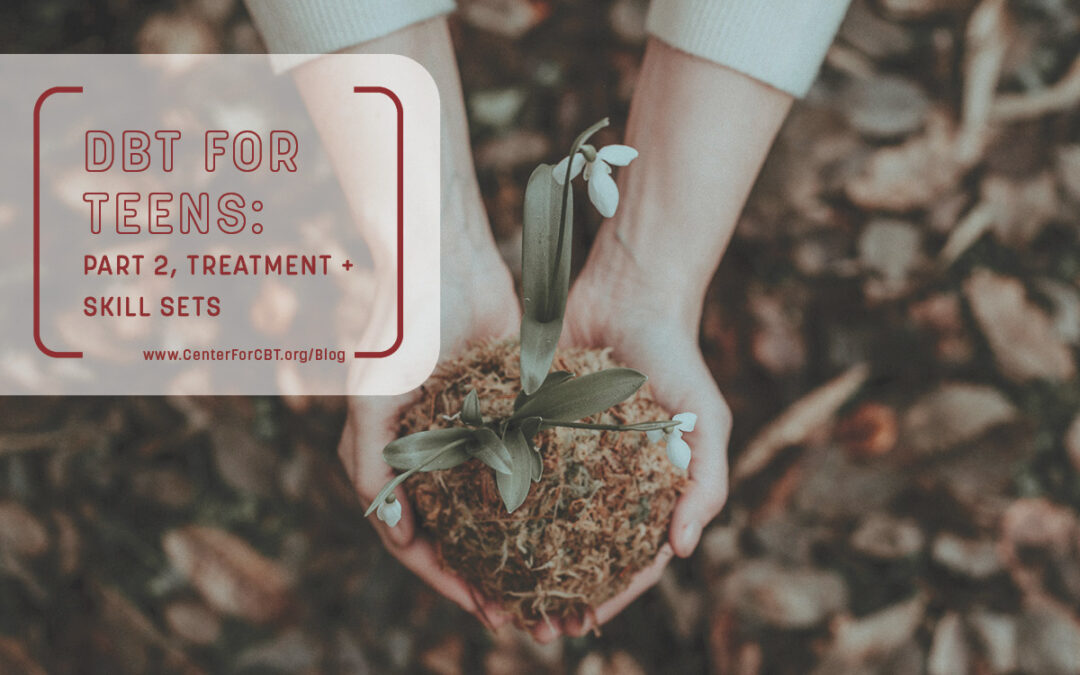What Makes DBT for Teens Different from Other Treatments?
Therapists work with teens to build motivation by understanding and validating their experiences and related emotions and helping them to identify the ways in which therapy can help. By working on behaviors that interfere with quality of life, teens learn how to effectively manage and accept their emotions, and develop more effective ways of thinking. In each session, DBT therapists prioritize which behaviors to work on based on what is most concerning, starting with life-threatening and harmful behaviors, such as suicidal thoughts and non-suicidal self-injury. The primary goal is to help recognize patterns of thoughts, feelings, emotions, and behaviors which contribute to these difficulties, and help teens apply intervention skills which are more adaptive or healthy. Next addressed are behaviors that can interfere with engagement in therapy, such as teens not wanting to come to sessions or avoiding discussions that focus on difficult feelings. DBT treatment understands that addressing painful emotions is a difficult undertaking, and works to improve teens’ relationship with their own emotions. After addressing these challenges, therapy focuses on those which interfere with a teen’s quality of life, such as negative self-image, increased arguments with family, social anxiety, and urges to use substances.
Main Components of Comprehensive DBT
An effective DBT treatment approach is a comprehensive one, meaning it is developed through four main components. Each of these offers a unique type of support to teens and their families, creating a well-rounded approach that offers help when it is needed most.
- Multi-family skills group: The goal of skills group is to teach and equip teens and their families with skills to improve their lives. Caregiver involvement in treatment has been shown to make treatment more effective, teaching parents and other adults in a teen’s life how to be coaches for their teen at home. In a class-like format with handouts, take-home exercises, and experiential activities, participants learn key DBT skills.
- Individual therapy: Individual sessions help motivate teens for change. DBT therapists work to be collaborative and genuine, building a therapeutic relationship that invites feedback, honesty, and trust. Therapists work to help teens learn to tolerate distress, validate emotions and accept things as they are, while also working to help teens change patterns of thoughts, emotions and behaviors which may contribute to challenges such as depression, self-harm, and suicidal thinking.
- Phone coaching outside of sessions: Teens are encouraged to call their therapists outside of sessions for brief phone calls during challenging situations to identify and apply strategies to effectively cope. These “coaching calls” help teens apply the skills they are learning to their real-world environment. In many cases, caregivers who attend the multi-family skills groups may also receive coaching from a DBT therapist to help parents interact more effectively with their teens.
- A consultation team of therapists: Doing DBT is very fulfilling, and it is also hard work. For this reason comprehensive DBT is not taught by just one therapist, but by a team of DBT therapists to ensure that teens and their families receive the highest possible quality of care. Just as we encourage teens to reach out to multiple adults in their life for support, DBT therapists rely on their fellow team members to help offer a more effective treatment.
DBT Skill Sets
To help teens and families address challenging behaviors, DBT for teens teaches 5 main skill sets. These are taught in the weekly multi-family skills group so that teens and their caregivers can practice them together.
- Mindfulness: Mindfulness, which generally comes from Buddhist and Hindu roots, teaches increased awareness of thoughts and feelings in the present moment without judgment. It also increases one’s ability to observe emotions and urges without necessarily acting on them. This is a core skill in DBT— without this skill, it is not possible to implement the others.
- Emotion Regulation: Is a set of techniques that help to reduce vulnerability to intense emotions and enhance skills in coping with overwhelming emotions. This includes taking care of physical health, changing difficult emotions, and teaching prevention and planning skills.
- Distress Tolerance: These skills help teens get through difficult moments or crises without making the moment or emotions “worse.” They can also help teens abstain from engaging in harmful behavior.
- Interpersonal Effectiveness: The goals of this skill set are to learn how to maintain healthy relationships, ask for needs to be met in an effective manner, and maintain self-respect. By communicating and managing relationships effectively, individuals can help themselves achieve their goals.
- Walking the Middle Path: These skills help teens and families avoid emotional and behavioral extremes, navigate family conflict, and learn to understand and validate each other’s feelings.
As therapists, we know that many families and teens coming to us have at times felt hopeless and exhausted. DBT therapists work to help teens find the tools to be able to climb that ladder out of the painful world they live in and into a more hopeful future, equipped with skills and support. Progress can sometimes feel like two steps forward and one step back down the ladder, especially when problems have been so long-lasting. Even so, we recognize that’s still one step forward in the direction of an improved life for teens and families. As DBT therapists we have a strong support for this treatment because we’ve seen it work, and we want to be able to use it to help more teens and their families. As a trio of therapists, teens, and parents, we are a team working together to build lives worth living.
Want to know more about DBT? Check out Dr. Brilliante’s introduction to Dialectical Behavior Therapy.



